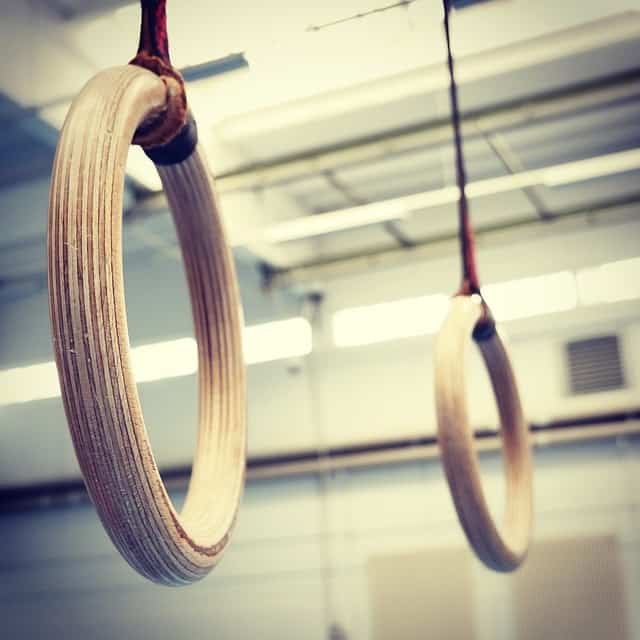Gymnastics rings are typically made from birch wood which is chosen for its strength, durability, and grip-enhancing properties. It provides a smooth and comfortable grip for gymnasts, allowing them to maintain a secure hold during various exercises and routines. Other types of wood, such as maple or beech, may also be used for gymnastics rings, but birch is the most prevalent due to its desirable qualities for this specific application.
Below we’ll go into more detail regarding gymnastics rings including the other types of wood often used, what benefit each wood offers and the design of the rings.
How Gymnastics Rings Are Made
The process of forming wooden gymnastics rings typically involves the use of a lathe. A lathe is a woodworking machine that rotates a piece of wood on its axis while a cutting tool shapes it into the desired form.
To form wooden gymnastics rings, a solid block or cylinder of wood is mounted on the lathe, and it is gradually shaped and smoothed as the lathe spins the wood. This allows for precise shaping of the rings, including creating the desired diameter and thickness.
Skilled craftsmen or manufacturers use the lathe machine to produce high-quality wooden gymnastics rings with consistent dimensions and smooth finishes.
Gymnastics rings made from wood typically have a standard diameter of approximately 28-32 millimeters (1.1-1.25 inches). The thickness of the rings can vary, but it is commonly around 28-32 millimeters (1.1-1.25 inches) as well.
These dimensions are designed to provide a comfortable and secure grip for gymnasts while maintaining the necessary strength and stability for various exercises and movements.
Gymnastics Rings Are Typically Made From 5 Different Wood Species
Here’s a revised table highlighting the benefits of using different types of wood for gymnastics rings:
| Wood Used | Benefits |
|---|---|
| Birch | Lightweight, durable, provides a firm grip, resists warping |
| Maple | Strong, dense, offers excellent stability and durability |
| Beech | Smooth surface, good grip, absorbs shock, resists moisture damage |
| Ash | High strength-to-weight ratio, flexible, resists impact |
| Oak | Hard, sturdy, long-lasting, offers excellent load-bearing capacity |
These are general benefits associated with each wood type. However, it’s important to note that the specific characteristics may vary based on factors like wood quality, finish, and manufacturing process. Choosing the right wood for gymnastics rings depends on personal preferences and requirements.
Gymnastic Ring Ropes Are Made From Similarly Strong Materials
The ropes that are attached to gymnastics rings are typically made from strong and durable materials that can withstand the weight and movements of the gymnast. Common materials used for gymnastics ring ropes include nylon, polyester, or a combination of both.
These materials are known for their high tensile strength, abrasion resistance, and flexibility, making them suitable for the dynamic nature of gymnastics routines. The ropes are securely fastened to the rings using specialized hardware to ensure stability and safety during training and performance.
Gymnastics Rings Have Multiple Uses
The gymnastics rings are primarily used in artistic gymnastics and calisthenics. The sports that take place on the gymnastics rings include:
- Gymnastics: The rings are used in artistic gymnastics as part of the men’s apparatus events. Gymnasts perform various strength, balance, and swinging movements on the rings, showcasing their upper body strength and control.
- Calisthenics: Rings are also commonly used in calisthenics training and competitions. Calisthenics is a form of bodyweight training that emphasizes strength, flexibility, and body control. Athletes perform a wide range of exercises on the rings, such as dips, pull-ups, muscle-ups, and various static holds.
- CrossFit: Gymnastics rings are frequently incorporated into CrossFit training routines. CrossFit athletes use the rings for exercises like ring rows, ring dips, ring push-ups, and ring muscle-ups to develop upper body strength, stability, and coordination.
- Aerial Arts: In some aerial arts disciplines, such as aerial straps, performers use similar apparatuses to gymnastics rings to showcase strength, flexibility, and aerial skills.
Overall, the gymnastics rings are versatile equipment that offers a wide range of exercises and movements, making them popular in various sports and training disciplines.

